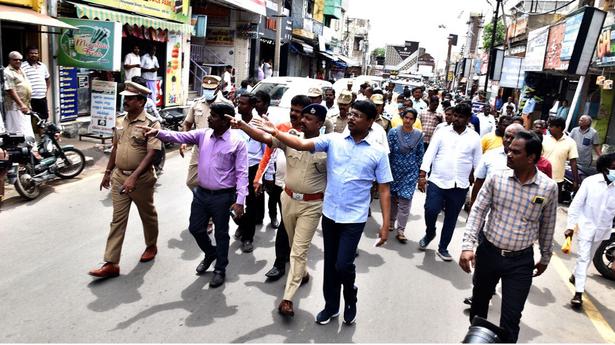
Eviction drive on Girivalam path in Tiruvannamalai begins
The Hindu
The path has been encroached along its entire 14-km route by petty shops and eateries
The removal of encroachments, mostly petty shops, roadside eateries and extension of commercial establishments, on the Girivalam path near Arunchalaeswarar temple in Tiruvannamalai commenced on Saturday to restore the original space of the path. Accompanied by Superintendent of Police (SP) K.Karthikeyan, Collector B. Murugesh inspected the demolition drive that was jointly undertaken by the State Highways, police, revenue, and HR&CE departments and Tiruvannamalai municipality.
Officials said that the girivalam path has been encroached along its 14-km route, taking advantage of the pandemic for the past two years as officials hesitated to undertake a major demolition drive during the pandemic due to overcrowding. Prior to the pandemic, such a drive was taken up at least once a month, which acted as a deterrent against encroachments.
The drive was monitored by K. Raghuraman, Assistant Divisional Engineer (ADE), State Highways. “As the temple town has returned to normalcy, the drive was taken up to prevent congestion along the girivalam path,” V. Vetrivel, Revenue Divisional Officer (RDO), Tiruvannamalai, told The Hindu.
Officials said that local traders have put up plastic chairs and tables along the entire girivalam route, and were running business right on the tiled footpaths with the easing of lockdown restrictions since last year (2021). The situation is worse between Rajagopuram of the temple and the Kamaraj statue, a distance of around two km, as revenue officials have identified at least 1,000 encroachments. Rest of the girivalam route has over 500 illegal structures. The girivalam path covers the town area and at least six villages. As part of the drive, the entire 14-km path was divided among seven units, with each unit having at least 25-30 officials and police personnel to demolish the illegal structures. Currently, the total width of the carriageway is 10 metres. However, the encroachments are mostly on the closed concrete stormwater drain that runs along the carriageway on both sides. These drains are two metres wide and used as footpath by the visitors. Due to its encroachment, visitors walk on the carriageway.











